|
About
Korea
General
Information
LANGUAGE
The official language of the symposium will be English and all papers
should
be written and presented in English.
No facility of simultaneous interpretation
will be available on site.
VISA
Any
foreign visitor wishing to enter the Republic of Korea must have a valid
passport. Visitors with confirmed outbound tickets may stay in Korea up to
30
days without visas; exceptions to this apply to: Citizens from Cambodia,
China,
India, Iran, Laos, Mongolia, Myanmar, Nepal, Palestine, the Philippines,
Sri
Lanka, and Vietnam in Asia - Nigeria and Ghana in Africa - Russia, Ukraine,
Belarus, Moldova, Armenia, Azerbaijan, Kazakhstan, Turkmenistan, Uzbekistan,
Tajikistan, Kyrgyz Stan, Georgia, and Macedonia in Europe-Cuba in the Americas.
CUSTOMS
An oral and written declaration for baggage must be made to the customs
officer
upon entry.
VACCINATION
and HEALTH
Vaccination certificates are not required for admission to the Republic of
Korea.
Participants are advised to take out insurance coverage for personal
accidents
and medical expenses.
CLIMATE
Seoul's average temperature in October ranges from 12°C to 19°C.
CURRENCY
The
unit of Korean currency is the Won(indicated
as£Ü).
Coin denominations are
10,
50, 100, and 500. Bank notes of 1,000, 5,000,
and 10,000 are frequently used.
The
exchange rate is subject to change with
market fluctuations. As of April 2004,
one US
dollar is equivalent to about 1,250 Korean
won.
ELECTRICITY
In
Korea, most of buildings have outlets for
220 volts only. Occasionally, outets for
both 100
and 220 volts are available. Always check
the power supply before using
electric
equipment.
EMERGENCY
Dial
119 for the fire and ambulance, and 112
for the police.
Tour
Attractions
|
SEOUL
|
|

|
Seoul has been the center of politics, economy,
culture,
and transportation of Korea for six centuries since Taejo,
the founder
of the Joseon Dynasty, moved the capital
here in the third year (1394) of his
reign. There are many
historical sites including ancient palaces. Seoul, one of
the
ten largest cities in the World, has become a huge
|
|
|
megalopolis with an area
of about 627 sq. km and a |
|
population of over 12 million.
|
|
ROYAL PALACES IN SEOUL
|
|
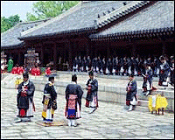
|
The most absorbing attraction of Seoul
must be the ancient
palaces, such as Gyeongbokgung, Ch'anggyeonggung,
Deoksugung and Gyeonghuigung. There remain the still
living
vestiges of the Joseon
Dynasty. Visitors can appreciate
the essence of the historical architecture of
Korea. Entering
into the gates of the palaces, you feel detached from the
|
|
|
bustling downtown of the
modern metropolis, which is a
|
|
unique
experience.
|
|
KOREAN FOLK VILLAGE
|
|
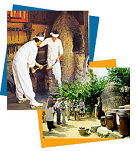
|
The
Korean Folk Village situated near Suwon about 41Km
south of Seoul, is modeled after
an authentic traditional
Korean way of life. Over 200 architectural relics and
models
of typical residence; of the Joseon Dynasty, houses of
¡°Yangban and
Nongbu¡±, noblemen and farmers from each
local Korean provinces are
assembled in
7,000,000 square
meters and offer realistic representations of utensils and
tool
making as well as the spices and flavors of traditional Korean
cuisine.
|
|
ICHON POTTERY
VILLAGE
|
|
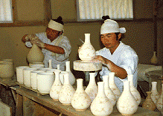
|
The Ichon Pottery tour provides a great opportunity to
appreciate one of
Korea¡¯s main cultural treasures, Pottery.
In Ichon Pottery Village, many
ceramists and potters settle
to reappear the beauty of Koryo celadon and Joseon
white
porcelain. You can watch the process how they are made and
|
|
|
kilns as well. And you will enjoy the special experience
of
|
|
making the ceramic for yourself.
|
|
GYEONGJU
|
|

|
Gyeongju, the ancient capital city of the Silla Kingdom,
is one of
Korea's
major tourist attractions and is called
"The Museu without a wall".
With its countless relics, it is
the site of historical interest and
reminiscence of 1,000
years of the Silla Kingdom's remarkable past. UNESCO has
recognized the value of Korean culture by including the eighth
|
|
|
-
century Bulguksa
Temple and the Seokguram Grotto on its
|
World
Heritage List. Indeed every spot
in this city will take
you back to the glory and grandeur of the ancient
kingdom.
It takes 40 minutes by flight and four and a half hours by
train from
Seoul.
|
|
JEJU ISLAND
|
|
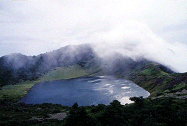
|
The Hawaii of Korea, Jeju Island is filled with unique ancient
myths and
legends of the three abundance stones, wind and
women. Acclaimed for its
subtropical climate and known for
no beggars, thieves and doors, Jeju Island is
considered as
one of the ten most unspoiled tourist paradises in the world
as
tourist destination for Honeymooners.
|
Korean Foods
|




|
|
GALBI
|
|
|
Galbi-gui is an excellent method for
cooking short ribs according to Korean tradition.
The short ribs are marinated
over-night, and grilled over a charcoal or gas fire at
the table. At
restaurants, a hostess usually assists by cutting the cooked short ribs
into
bite-sized pieces.
|
|
BIBIM-BAP
|
|
|
Bibim-bap is a bowl of hot rice and
pan-fried meat garnished with a variety of
vegetables. As the word, 'bibim', or
to 'stir together' indicates, the dish is eaten
after stirring the rice and
vegetables together with a dollop of hot pepper paste
sauce. And Dolsot
Bibim-bap is cooked and served in a dolsot, or a stone pot, the
insulating
capacity of the stone keeps your food warm until the last bite.
|
|
GIMCHI
|
|
|
Gimchi, or vegetables salted and fermented for long
storage, is the most important
component of a Korean meal, and dates back
almost a thousand years. According
to recent scientific research, gimchi is
particularly rich in vitamins and minerals.
Gimchi produces natural acids
during the fermentation process, which stimulate the
appetite, as well as clean
the intestines with lactic acid. Gimchi comes in a variety
of flavors, depending on its
main ingredients and the preparation method. There
are more
than 100 types of gimchi.
|
|
RICE
CAKE and KOREAN COOKIES
|
|
|
Tteok is traditional Korean cake made from rice powder. Koreans
prepare it for festive
occasions such as birthdays and weddings as well as for
ancestral memorial services.
Hangwa or Korean Cookies are appreciated for its
artistic and decorative colors and
patterns as well as for its pleasing sweet
taste.
|
Traditional
Activities
|
TAEGWONDO
|
|

|
Taegwondo is Korean traditional martial art for men
and women
of all ages. It helps people keep their health through studying
the
skills of defense and offense. Taegwondo has been in
existence for
thousands of
years and is practiced as both a
method of self-defense. Its benefits, long
known by Koreans,
|
|
|
are being spread around the world by over 4,000 masters
|
who
are actively teaching Taegwondo in other countries.
There are about 50,000,000 Taegwondo
students all over
the world.
|
|
DADO
|
|
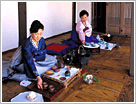
|
In the west, several traditional beverages such as hot cocoa
and hot
spiced cider are popular. In Korea, green tea is the
most popular
traditional
beverage. From ancient times there
has been a tradition of serving green tea
for guests in Korea.
The etiquette for preparing, serving and drinking tea is
known
as the "Dado" tea ceremony - "Da" implies tea and
"do" is the
|
|
|
art of making or doing something. When pouring tea into
cups
|
after brewing, you are not supposed to immediately fill the cup.
Rather
you pour a little into each cup in turn and then go around
again because the
flavor and color of the tea get stronger as
time passes.
|
|
PUNGMUL
|
|

|
Pungmul
is a grand outdoor performance of Korean folk music in
which dances, songs, and
dramas are intermingled. It is roughly
equivalent to a western musical, but has
very different origins
and aims. Performing pungmul expresses wishes for a rich
harvest of grain and a good catch of fish. It also promotes amity
|
|
|
and solidarity
among villagers, while encouraging cooperation
|
and a sense of identity as
Koreans.
|
|
TRADITIONAL
MARRIGE
|
|

|
As in any culture, marriage in Korea
represents one of
the major
stages of ones life. The traditional ceremonies surrounding the
event
have deep Confucian roots, symbolizing the importance
of the families involved.
Ceremonies have some differences
according to the region where they are
performed and the social
|
|
|
status of the participants, but they all follow the
same basic
|
format.
|
|